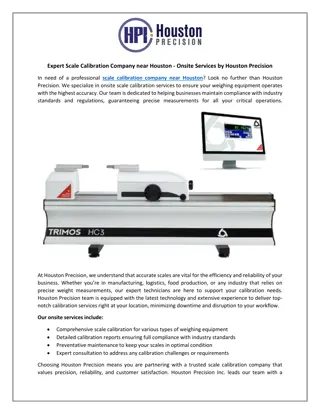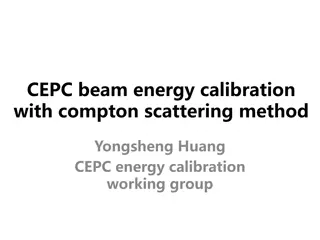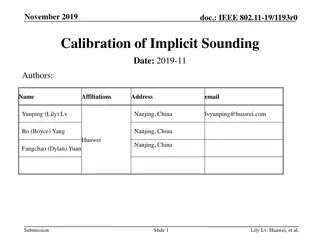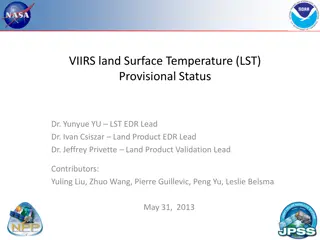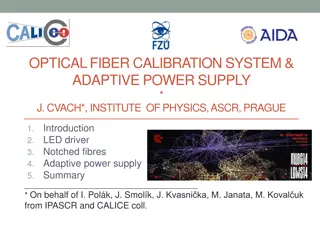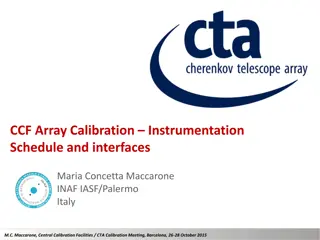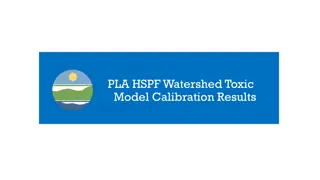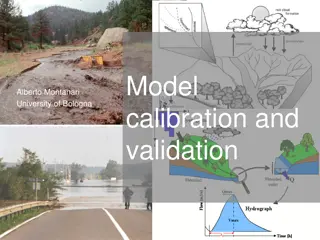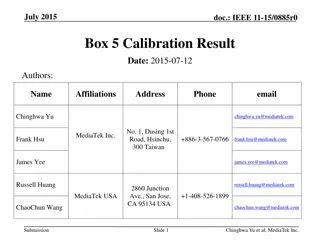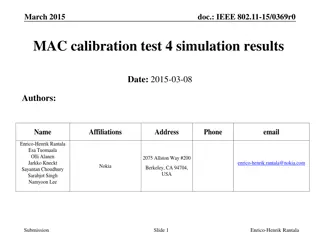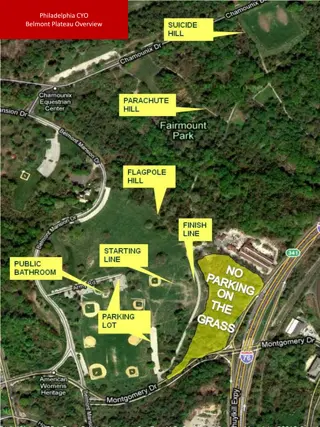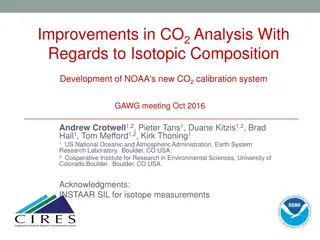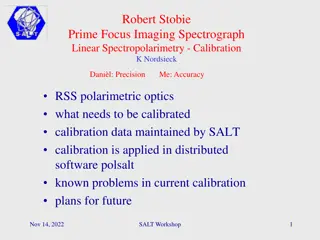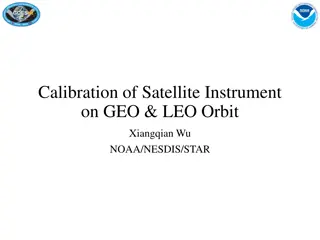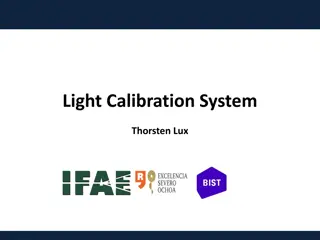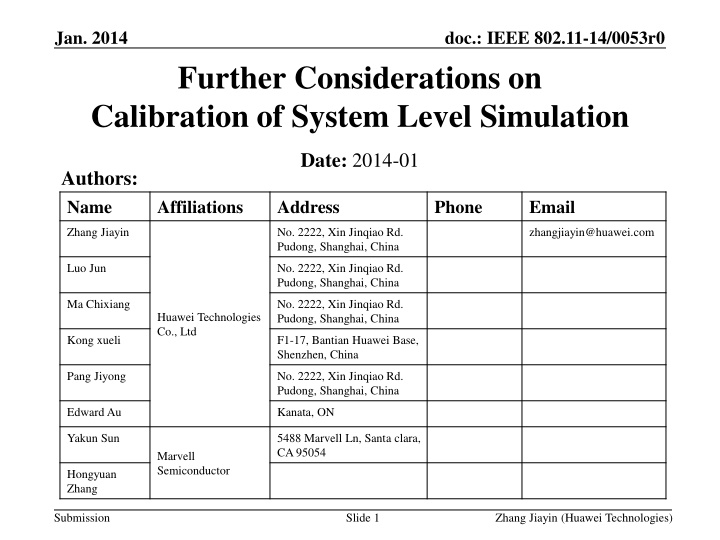
Further Considerations on Calibration of System Level Simulation
This document from Jan 2014 presents further considerations on the calibration of an integrated system level simulation for IEEE 802.11 standards. It discusses the importance of calibration, background methodology, calibration scenarios, and more.
Download Presentation

Please find below an Image/Link to download the presentation.
The content on the website is provided AS IS for your information and personal use only. It may not be sold, licensed, or shared on other websites without obtaining consent from the author. If you encounter any issues during the download, it is possible that the publisher has removed the file from their server.
You are allowed to download the files provided on this website for personal or commercial use, subject to the condition that they are used lawfully. All files are the property of their respective owners.
The content on the website is provided AS IS for your information and personal use only. It may not be sold, licensed, or shared on other websites without obtaining consent from the author.
E N D
Presentation Transcript
Jan. 2014 doc.: IEEE 802.11-14/0053r0 Further Considerations on Calibration of System Level Simulation Date: 2014-01 Authors: Name Affiliations Address Phone Email Zhang Jiayin No. 2222, Xin Jinqiao Rd. Pudong, Shanghai, China zhangjiayin@huawei.com Luo Jun No. 2222, Xin Jinqiao Rd. Pudong, Shanghai, China Ma Chixiang No. 2222, Xin Jinqiao Rd. Pudong, Shanghai, China Huawei Technologies Co., Ltd Kong xueli F1-17, Bantian Huawei Base, Shenzhen, China Pang Jiyong No. 2222, Xin Jinqiao Rd. Pudong, Shanghai, China Edward Au Kanata, ON Yakun Sun 5488 Marvell Ln, Santa clara, CA 95054 Marvell Semiconductor Hongyuan Zhang Submission Slide 1 Zhang Jiayin (Huawei Technologies)
Jan. 2014 doc.: IEEE 802.11-14/0053r0 Abstract Further considerations on the calibration of an integrated system level simulation are presented Submission Slide 2 Zhang Jiayin (Huawei Technologies)
Jan. 2014 doc.: IEEE 802.11-14/0053r0 Background (1/2) Three types of simulation methodologies are presented in [1], including PER Simulation, PHY System simulation and MAC System simulation. An Integrated System Level Simulation, which can take into account both PHY and MAC features for performance evaluation, is proposed in [2]. There are also a number of presentations, e.g., [3], that details a step-by-step calibration. Submission Slide 3 Zhang Jiayin (Huawei Technologies)
Jan. 2014 doc.: IEEE 802.11-14/0053r0 Background (2/2) In this presentation, we aim at providing further consideration on the following topics: Select an appropriate scenario for calibration Recommend metric and methodology for long term SNR/SINR calibration Instantaneous SNR/SINR calibration PHY SLS calibration Integrated SLS calibration Submission Slide 4 Zhang Jiayin (Huawei Technologies)
Jan. 2014 doc.: IEEE 802.11-14/0053r0 Why Calibration? To validate the modeling methodology of all building blocks of a system level simulator. To provide a common baseline for all companies to develop their simulators and align their system simulation results. Submission Slide 5 Zhang Jiayin (Huawei Technologies)
Jan. 2014 doc.: IEEE 802.11-14/0053r0 Calibration Scenario Selection The scenario should be able to test all building blocks; clearly defined; run efficiently. 30 BSS A STA locations BSS B STA locations assuming (xb,yb)=(40,20) BSS C STA locations assuming (xb,yb)=(-40,-20) 27 20 15 21 9 3 10 26 8 11 23 2 Since the simulation scenarios for HEW [4] are yet to be finalized, a simple and fixed deployment can be considered. e.g. 11ac OBSS enterprise scenario [5] or one of the simulation scenarios currently discussed. 5 29 4 10 0 14 20 13 19 22 25 17 7 28 16 1 -10 12 6 30 24 18 -20 -30 -50 -40 -30 -20 -10 0 10 20 30 40 50 Submission Slide 6 Zhang Jiayin (Huawei Technologies)
Jan. 2014 doc.: IEEE 802.11-14/0053r0 Step 1: Long Term SNR/SINR Calibration Metric: CDF of long term SNR/SINR of each potential communication link Method: Signal power: received signal power from the transmitting node to the receiving node within a BSS. Interference power: the sum of average effective received power from all interfering BSS (all BSSes other than the BSS of target STA/AP). Average effective received power: total received power at the target node averaged by the total number of AP and STA in one interfering BSS assuming all these nodes in this interfering BSS are transmitting. + = AP P 1 AP STA P n m , DL m n 1 k m m + + AP STA P k m STA STA P j N 0 1 n j k SINR k n STA , UL m n k j n n + + AP AP k STA AP P j P N 0 + 1 n k k Submission Slide 7 Zhang Jiayin (Huawei Technologies)
Jan. 2014 doc.: IEEE 802.11-14/0053r0 Step 1: Long Term SNR/SINR Calibration Illustrative example by considering 11ac OBSS enterprise scenario [5] Submission Slide 8 Zhang Jiayin (Huawei Technologies)
Jan. 2014 doc.: IEEE 802.11-14/0053r0 Step 2: Instantaneous SNR/SINR Calibration Metric: CDF of instantaneous SNR/SINR of each potential communication link Method: Signal power: received signal power from the transmitting STA to the receiving STA within a BSS. Interference power: sum of all interfering STAs/APs based on PHY system simulation. Simple MAC assumption can be assumed, such as CCA-only mechanism mentioned in [1]. Submission Slide 9 Zhang Jiayin (Huawei Technologies)
Jan. 2014 doc.: IEEE 802.11-14/0053r0 Step 3: PHY SLS Calibration Metric: Area throughput/throughput per BSS and CDF of per STA throughput Method: Full buffer traffic is assumed; Simple MAC mechanism, which is the same as Step 2, should be used; PHY abstraction should be used; PHY features, such as MIMO scheme, need to be clarified. Submission Slide 10 Zhang Jiayin (Huawei Technologies)
Jan. 2014 doc.: IEEE 802.11-14/0053r0 Step 4: Integrated SLS Calibration Metric: The same as Step 3, i.e., area throughput/throughput per BSS and CDF of per STA throughput. Method: The same as Step 3 except a more detailed MAC mechanism, e.g., CSMA/CA, should be included. Remarks: Additional calibration of the baseline for each scenario is required, which can be merged with step 4. Submission Slide 11 Zhang Jiayin (Huawei Technologies)
Jan. 2014 doc.: IEEE 802.11-14/0053r0 Further Consideration on SLS Calibration Several interim calibration can be carried on in parallel if necessary: Traffic model; Small-scale fading channel; PHY abstraction. Network deployment of HEW simulation scenarios can also be calibrated prior to baseline calibrations. Submission Slide 12 Zhang Jiayin (Huawei Technologies)
Jan. 2014 doc.: IEEE 802.11-14/0053r0 Summary A step by step calibration is recommended for system level simulation, including long term /instantaneous SNR/SINR calibration, PHY SLS calibration and integrated SLS calibration. Submission Slide 13 Zhang Jiayin (Huawei Technologies)
Jan. 2014 doc.: IEEE 802.11-14/0053r0 Reference [1] 11-13-1051-01-0hew-evaluation-methodology [2] 11-14-0059-00-0hew-Integrated-System-Level- Simualtion [3] 11-13-1392-00-0hew-methodology-of-calibrating- system-simulation-results [4] 11-13-1001-05-0hew-simulation-scenarios-document- template [5] 11-09-0451-16-00ac-tgac-functional-requirements-and- evaluation-methodology Submission Slide 14 Zhang Jiayin (Huawei Technologies)
Jan. 2014 doc.: IEEE 802.11-14/0053r0 Appendix: Parameters for Calibration in Step 1 Parameter Value 5.57GHz Central frequency 20MHz Bandwidth AP: 15dBm Transmission power STA: 15dBm Antenna type: omni-directional antenna Antenna gain: 0dB Antenna configuration AP antenna number:1 STA antenna number: 1 0dB Implementation loss Noise floor -174 dBm/Hz AP: 10dB Noise figure STA: 10dB 802.11 TGac channel model D (LOS/NLOS) Shadow fading std. dev. (dB): 3 (before dBP); 5 (after dBP) dBP: 10m Channel model Submission Slide 15 Zhang Jiayin (Huawei Technologies)

